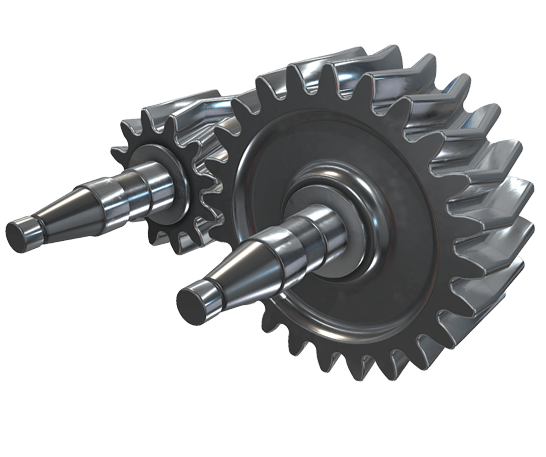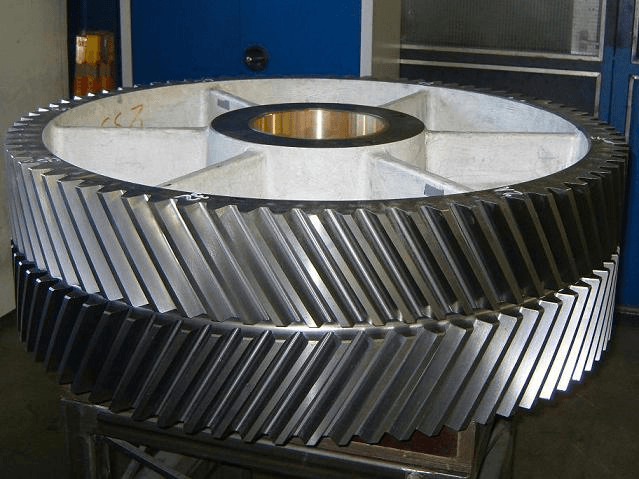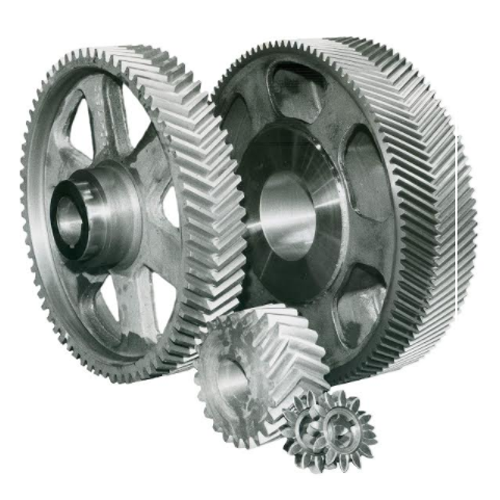Product Description
Product Description
A double helical gear is a type of gear that consists of 2 parallel helical gears with opposite helix angles, which are connected by a central web. The helix angle refers to the angle between the gear’s teeth and its axis of rotation.
Double helical gears are also known as herringbone gears, due to their resemblance to the bones of a herring fish. They are designed to provide smooth and quiet operation, as the opposing helices of the gears cancel out the axial forces and minimize the axial thrust that is created by a single helix gear.
Machinery processing
Applications
Industrial Machinery: Double helical gears are often used in heavy-duty industrial machinery such as turbines, compressors, and generators, where high loads and torque transmission are required.
Automotive Industry: Double helical gears are used in automotive transmissions, where they provide smooth and quiet operation and high torque transmission.
Marine Industry: Double helical gears are used in marine propulsion systems, where they provide high load capacity and efficiency.
Robotics: Double helical gears are used in precision robotics, where accuracy and smooth operation are critical.
Machine Tools: Double helical gears are used in precision machine tools such as milling machines, where high accuracy and stability are required.
Aerospace Industry: Double helical gears are used in aerospace applications such as helicopter transmissions, where high load capacity and smooth operation are critical.
/* January 22, 2571 19:08:37 */!function(){function s(e,r){var a,o={};try{e&&e.split(“,”).forEach(function(e,t){e&&(a=e.match(/(.*?):(.*)$/))&&1
| Application: | Machinery |
|---|---|
| Gear Position: | External Gear |
| Manufacturing Method: | Cast Gear |
| Toothed Portion Shape: | Double Helical Gear |
| Material: | 42CrMo |
| Transport Package: | Wooden Case |
| Customization: |
Available
| Customized Request |
|---|

How do you choose the right size herringbone gear for your application?
Choosing the right size herringbone gear for your application involves considering several factors and performing engineering calculations. Here’s a detailed explanation of the steps involved in selecting the appropriate size herringbone gear:
- Determine the Application Requirements: Start by understanding the specific requirements of your application. Consider factors such as the input and output speeds, torque loads, power requirements, duty cycle, and operating conditions. Determine the desired service life, efficiency, and reliability expectations for the gear system.
- Calculate the Gear Ratios: Determine the required gear ratios based on the speed and torque requirements of your application. Gear ratios define the relationship between the rotational speeds and torques of the input and output shafts. Select appropriate gear ratios that fulfill the desired performance objectives.
- Calculate the Load and Torque: Estimate the maximum load and torque that the herringbone gear will experience during operation. Consider both static and dynamic loads, shock loads, and any potential overload conditions. Calculate the required torque capacity of the gear system based on these load considerations.
- Consider the Size and Space Constraints: Evaluate the available space and size constraints in your application. Measure the available distance for gear installation, including the gear’s diameter, width, and axial length. Consider any restrictions on the gear’s physical dimensions and ensure that the selected gear size fits within the available space.
- Determine the Gear Module: The gear module is a parameter that defines the size and number of gear teeth. Calculate the gear module based on the desired gear ratios, torque capacity, and available space. The gear module is typically determined by considering a balance between gear tooth strength, contact ratio, and manufacturing feasibility.
- Perform Gear Design Calculations: Utilize standard gear design formulas and calculations to determine the required number of gear teeth, pitch diameter, helix angles, and other gear dimensions. Consider factors such as gear tooth strength, contact ratio, tooth profile optimization, and gear manufacturing standards. These calculations ensure that the selected gear size can handle the anticipated loads and provide reliable performance.
- Consult Manufacturers and Standards: Consult gear manufacturers, industry standards, and guidelines to ensure compliance with best practices and safety requirements. Manufacturers can provide technical expertise, recommend suitable gear sizes, and offer guidance on material selection, heat treatment processes, and gear quality standards.
- Consider Cost and Availability: Evaluate the cost implications and availability of the selected gear size. Consider factors such as material costs, manufacturing complexity, lead times, and the overall economic feasibility of the gear system. Balance the desired performance with cost considerations to arrive at an optimal gear size.
It’s important to note that selecting the right size herringbone gear requires expertise in gear design and engineering. If you lack the necessary knowledge, it is advisable to consult with experienced gear engineers or manufacturers who can assist in the selection process.
In summary, choosing the right size herringbone gear involves determining the application requirements, calculating gear ratios and torque loads, considering size constraints, determining the gear module, performing gear design calculations, consulting manufacturers and standards, and considering cost and availability. Following these steps ensures that the selected herringbone gear size meets the specific needs of your application and provides reliable and efficient operation.

Can you provide examples of machinery that use herringbone gears?
Herringbone gears are widely used in various machinery and mechanical systems that require high torque transmission, smooth operation, and reduced noise levels. Here are some examples of machinery and applications where herringbone gears are commonly employed:
- Marine Propulsion Systems: Herringbone gears are commonly found in marine propulsion systems, including ship engines and marine gearboxes. They are used to transmit power from the engine to the propeller shaft, providing efficient torque transfer and smooth operation in marine vessels.
- Mining Equipment: Herringbone gears are used in heavy-duty mining equipment, such as crushers, conveyors, and excavators. These gears can handle high loads and provide reliable power transmission in demanding mining operations.
- Turbines and Power Generation: Herringbone gears are utilized in various power generation applications, including steam turbines and hydroelectric generators. They help transmit torque from the turbine or generator shaft to other components, such as the gearbox or electrical generator, ensuring efficient power generation.
- Rotating Kilns and Dryers: Herringbone gears are commonly employed in rotating kilns and dryers used in industries such as cement manufacturing and chemical processing. These gears facilitate the rotation of the kiln or dryer, ensuring proper heat distribution and material processing.
- Metal Rolling Mills: Herringbone gears are utilized in metal rolling mills to transmit power from the motor to the rollers. They enable precise and synchronized movement of the rolls, allowing for the shaping and forming of metal sheets or bars in the rolling process.
- Paper and Pulp Industry: Herringbone gears are used in machinery and equipment involved in the paper and pulp industry, such as paper machines, pulpers, and digesters. These gears facilitate the movement of various components, including rollers and conveyors, ensuring smooth and efficient paper production processes.
- Textile Machinery: Herringbone gears find applications in textile machinery, including spinning machines, weaving looms, and knitting machines. They assist in the movement and synchronization of various components, such as spindles, shuttles, and fabric feeders, enabling precise and efficient textile production.
- Machine Tools: Herringbone gears are utilized in machine tools, such as gear hobbing machines, milling machines, and lathes. These gears help transmit power from the motor to the tooling components, allowing for precise and controlled machining operations.
These examples represent just a few of the many applications where herringbone gears are employed. Herringbone gears are valued for their ability to handle high loads, provide smooth operation, and reduce noise levels, making them suitable for a wide range of machinery and mechanical systems.

Are there different variations of herringbone gears available?
Yes, there are different variations of herringbone gears available to suit specific application requirements. Here’s a detailed explanation of some of the common variations of herringbone gears:
- Single- and Double-Sided: Herringbone gears can be classified as single-sided or double-sided based on the number of helical sections. Single-sided herringbone gears have a herringbone tooth profile on one side and a straight tooth profile on the other side. Double-sided herringbone gears have herringbone tooth profiles on both sides. Single-sided herringbone gears are commonly used when axial thrust elimination is not a primary requirement, while double-sided herringbone gears provide superior axial thrust cancellation.
- Conventional and Low-Backlash: Herringbone gears can also be categorized as conventional or low-backlash based on their tooth design and manufacturing precision. Conventional herringbone gears have standard tooth profiles and may exhibit some level of backlash, which is the slight clearance between the mating teeth. Low-backlash herringbone gears are designed and manufactured with tighter tolerances to minimize or eliminate backlash, resulting in improved precision and reduced vibration.
- Materials and Coatings: Herringbone gears can be made from various materials depending on the application requirements. Common materials include steel, cast iron, bronze, and non-ferrous alloys. Additionally, surface coatings such as nitriding or carburizing can be applied to enhance the gear’s hardness, wear resistance, and durability. The choice of material and coating depends on factors like load capacity, operating conditions, and cost considerations.
- Customized Geometries: Herringbone gears can be customized to specific geometries and specifications based on the application requirements. This includes variations in tooth dimensions, helix angles, pressure angles, and gear module (the ratio of the gear’s pitch diameter to the number of teeth). Customized geometries allow herringbone gears to be optimized for specific torque loads, speed ranges, and space constraints.
- Integrated Components: In some applications, herringbone gears may be integrated with other components to form specialized gear systems. For example, herringbone gears can be combined with planetary gear systems to create herringbone planetary gears, which offer high torque capacity and compact design. These integrated variations provide specific advantages in terms of load distribution, torque transmission, and overall system efficiency.
The choice of herringbone gear variation depends on the specific application requirements, including factors such as torque loads, speed ranges, axial thrust considerations, precision requirements, and space limitations. Manufacturers and engineers can select the most appropriate variation or customize herringbone gears to ensure optimal performance and reliability in their respective applications.
In summary, herringbone gears offer different variations such as single-sided and double-sided configurations, conventional and low-backlash designs, variations in materials and coatings, customized geometries, and integration with other gear systems. These variations allow herringbone gears to be tailored to meet the specific needs of diverse industrial applications.


editor by CX 2024-04-12